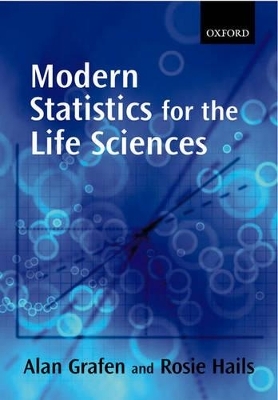
Modern Statistics for the Life Sciences
Oxford University Press (Verlag)
978-0-19-925231-2 (ISBN)
This textbook teaches statistics in a different way. It is aimed at undergraduate students in the life sciences, and it will also be invaluable for many graduate students. It makes the powerful methods of model formulae and the General Linear Model accessible to undergraduates for the first time. The computer revolution has finally made it possible to teach life sciences undergraduates how to use the statistics they really need to know - this book provides the course materials needed to fulfil that possibility. This text presents the fundamental statistical concepts without being tied to any one statistical package. Three supplements available on the web site provide all the information you need to conduct the analyses in either Minitab, SAS, or SPSS. All datasets are available on the web site.
Degrees in Experimental Psychology, Economics and Zoology have exposed Professor Alan Grafen to various different statistical traditions, and also to his main research interest in how adaptive complexity arises through natural selection. He has been interested in statistics since he was an undergraduate, learned mathematical theory of statistics as a graduate student, and encountered modern statistics in the package GLIM as a research student. The impetus to produce a systematic introduction for undergraduates to model formulae and the General Linear Model came from his appointment in 1989 to a lectureship in Quantitative Biology at Oxford University. Degrees in Zoology, Pest Management and Population Dynamics led Dr Rosie Hails toward the more quantitative areas of ecology. Most of her research career has developed the theme of the potential impacts of biological invasions, with reference to both natural invasions and genetically modified organisms. In the early 1990s, she was involved in the first experiments monitoring the behaviour and population dynamics of transgenic plants in natural habitats across the UK with Professor Mick Crawley. More recently, at the NERC Centre for Ecology and Hydrology in Oxford, her research themes have included the dynamics of wildlife diseases as well as plants. In moving to Oxford, Dr Hails became involved in teaching Professor Alan Grafen's undergraduate course, principally through a position at St Anne's College.
Why use this book ; 1. An introduction to the analysis of variance ; 2. Regression ; 3. Models, parameters and GLMs ; 4. Using more than one explanatory variable ; 5. Designing experiments - keeping it simple ; 6. Combining continuous and categorical variables ; 7. Interactions - getting more complex ; 8. Checking the models A: Independence ; 9. Checking the models B: The other three assumptions ; 10. Model selection I: Principles of model choice and designed experiments ; 11. Model selection II: Data sets with several explanatory variables ; 12. Random effects ; 13. Categorical data ; 14. What lies beyond? ; Answers to exercises ; Revision section: The basics ; Appendix I: The meaning of p-values and confidence intervals ; Appendix II: Analytical results about variances of sample means ; Appendix III: Probability distributions ; Bibliography
| Erscheint lt. Verlag | 21.3.2002 |
|---|---|
| Zusatzinfo | numerous figures |
| Verlagsort | Oxford |
| Sprache | englisch |
| Maße | 171 x 246 mm |
| Gewicht | 617 g |
| Themenwelt | Geisteswissenschaften ► Psychologie |
| Mathematik / Informatik ► Mathematik ► Statistik | |
| Naturwissenschaften ► Biologie ► Allgemeines / Lexika | |
| Naturwissenschaften ► Biologie ► Humanbiologie | |
| ISBN-10 | 0-19-925231-9 / 0199252319 |
| ISBN-13 | 978-0-19-925231-2 / 9780199252312 |
| Zustand | Neuware |
| Haben Sie eine Frage zum Produkt? |
aus dem Bereich


